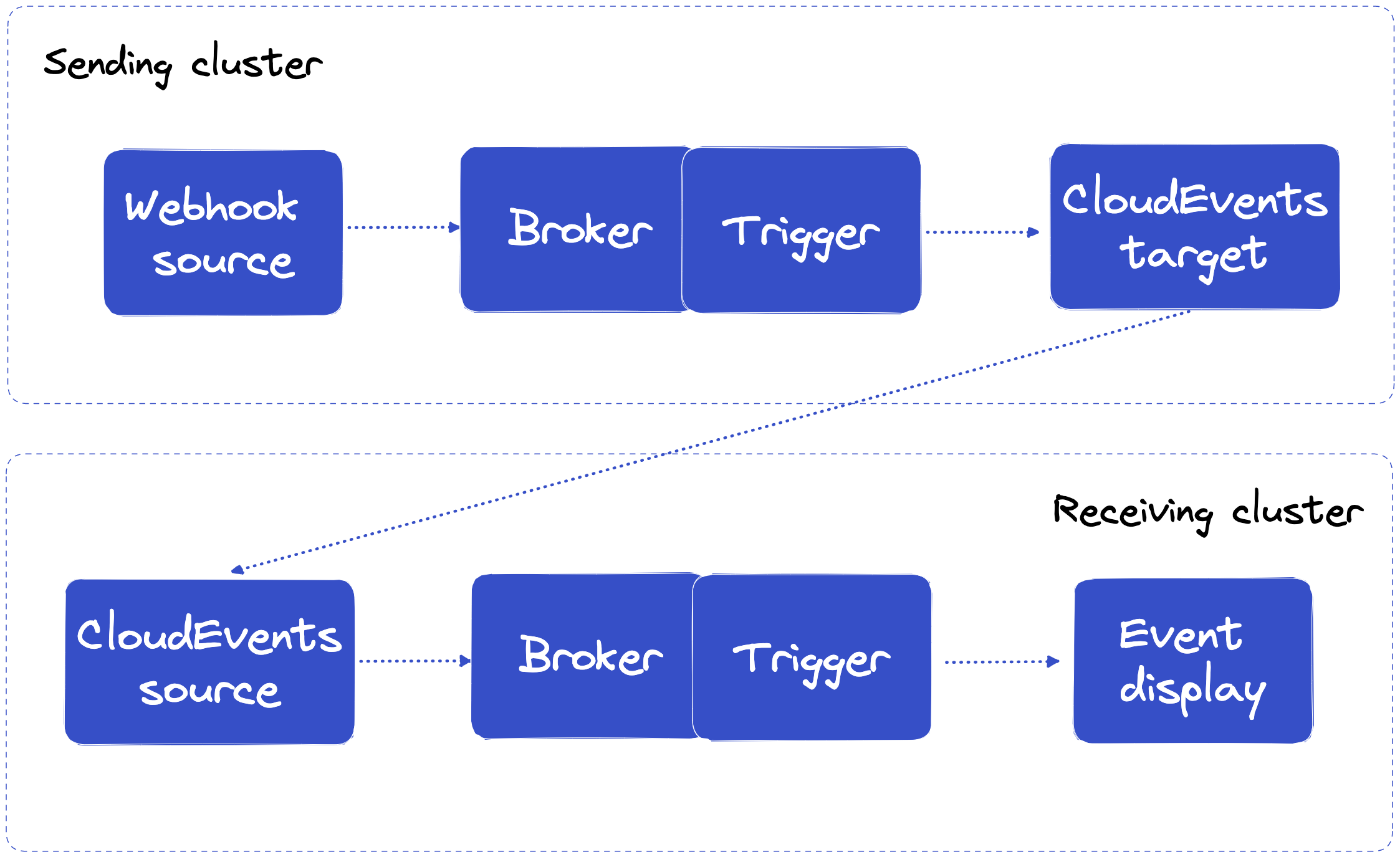Connecting TriggerMesh Clusters
Installation
Make sure you have completed the installation procedure before proceeding with any of the guides.
In this guide we will connect 2 TriggerMesh clusters that will be able to interchange CloudEvents flowing through them. You might want to connect multiple TriggerMesh instances to:
- Move events between environments. For example from production to staging in order to perform tests with actual events.
- Geographically distribute events among clusters.
- Perform Cluster migrations.
- Integrate heterogenous applications through real time events.
Scenario
For this scenario we will need to setup 2 TriggerMesh clusters that we will call at this document ClusterSender and ClusterReceiver.
ClusterSender components:
Brokeris the temporary storage for CloudEvents.WebhookSourceis a CloudEvents producer that exposes an interface to accept HTTP post requests and, in return, emits cloud events.CloudEventsTargetis a CloudEvents consumer that receives events and then sends them to a user-configurable location.Triggerwill subscribe to CloudEvents at the Broker and send them to the CloudEventsTarget.
ClusterReceiver components:
Brokeris the temporary storage for CloudEvents.CloudEventsSourcewill listen to CloudEvents from remote locations and send them to the Broker.event-displayservice will listen to CloudEvents and log them at the output console.Triggerwill subscribe to CloudEvents at the Broker and send them to the EventDisplay.

Events produced at the WebhookSource will flow as depicted above until they reach the EventDisplay at the second cluster.
Setup
Local setup
You can use a local setup by creating 2 kind clusters.
Add LoadBalancer support to the receiver cluster by following kind instructions.
You can switch to each configured cluster using kubectl config use-context command.
Receiver Cluster
Receiver cluster
Make sure your kubectl configuration is pointing to the receiver cluster.
Create the Broker as the host for this cluster's CloudEvents:
Create a service that runs the event_display image. We will look for received events by looking at the logs of this service.
apiVersion: apps/v1
kind: Deployment
metadata:
name: event-display
spec:
replicas: 1
selector:
matchLabels: &labels
app: event-display
template:
metadata:
labels: *labels
spec:
containers:
- name: event-display
image: gcr.io/knative-releases/knative.dev/eventing/cmd/event_display
---
kind: Service
apiVersion: v1
metadata:
name: event-display
spec:
selector:
app: event-display
ports:
- protocol: TCP
port: 80
targetPort: 8080
Using a Trigger we can link the event-display service with the broker to subscribe to all events flowing through it.
kind: Trigger
apiVersion: eventing.triggermesh.io/v1alpha1
metadata:
name: all-events-to-event-display
spec:
broker:
group: eventing.triggermesh.io
kind: MemoryBroker
name: receiver
subscriber:
ref:
apiVersion: v1
kind: Service
name: event-display
The CloudEventsSource component will expose an HTTP endpoint that ingest CloudEvents from external systems. We will configure this component to send ingested CloudEvents to the broker.
apiVersion: sources.triggermesh.io/v1alpha1
kind: CloudEventsSource
metadata:
name: gateway-in
spec:
sink:
ref:
apiVersion: eventing.triggermesh.io/v1alpha1
kind: MemoryBroker
name: receiver
After completing the setup for all the receiver cluster components, any CloudEvent sent to the CloudEventsSource public endpoint will flow throw the broker and be delivered to the event-display service.
We will retrieve and take note of the exposed URL at the CloudEventsSource, it will be used later at the the sender cluster.
Sender Cluster
Sender cluster
Make sure your kubectl configuration is pointing to the sender cluster.
Create the Broker that as the host for this cluster's CloudEvents:
A WebhookSource exposes and HTTP endpoint that receives HTTP POST requests and produces a CloudEvent to the broker.
apiVersion: sources.triggermesh.io/v1alpha1
kind: WebhookSource
metadata:
name: webhook
spec:
eventType: webhook.event
sink:
ref:
apiVersion: eventing.triggermesh.io/v1alpha1
kind: MemoryBroker
name: sender
The CloudEventsTarget component is able to subscribe to a broker (using a trigger), and forward events to a remote destination. We will configure this component using the endpoint exposed by the CloudEventsSource at the destination cluster, make sure you replace the placeholder text at the following command.
apiVersion: targets.triggermesh.io/v1alpha1
kind: CloudEventsTarget
metadata:
name: gateway-out
spec:
endpoint: <REPLACE-WITH-CLOUDEVENTSSOURCE-HTTP-ENDPOINT>
Subscribing the CloudEventsTarget to CloudEvents flowing through a broker is done via a trigger.
kind: Trigger
apiVersion: eventing.triggermesh.io/v1alpha1
metadata:
name: all-events-to-cloudeventstarget
spec:
broker:
group: eventing.triggermesh.io
kind: MemoryBroker
name: sender
subscriber:
ref:
apiVersion: targets.triggermesh.io/v1alpha1
kind: CloudEventsTarget
name: gateway-out
Receiving Events
With all components being setup we can now send an event into the WebhookSource at the sender cluster, and it should show up in the event-display service at the receiver cluster. We can make sure by looking at the receiving service logs.
First, lets retrieve the URL on which the Webhook is listening for incoming requests.
$kubectl get webhooksources.sources.triggermesh.io webhook
NAME READY REASON URL SINK AGE
webhook True http://webhooksource-webhook.default.127.0.0.1.sslip.io http://demo-mb-broker.default.svc.cluster.local 4m14s
Use curl or any HTTP capable client to post an event to the webhook.
curl -d '{"message": "greetings from sender cluster"}' http://webhooksource-webhook.default.127.0.0.1.sslip.io
$ kubectl logs deployments/event-display
Context Attributes,
specversion: 1.0
type: webhook.event
source: /apis/v1/namespaces/default/pingsources/periodic-event-producer
id: eddd0d10-64ef-4c82-bfc0-c0caea63a510
time: 2022-05-26T12:44:00.265933805Z
datacontenttype: application/json
Data,
{
"message": "greetings from sender cluster"
}
Further improvements
Triggers can be configured with filters to make sure only allowed CloudEvents travels between clusters. Refer to trigger's documentation for configuration options.
CloudEventsSource and CloudEventsTarget can be configured with HTTP Basic Authentication.
HTTP Basic Authentication
HTTP Basic Authentication is not encrypted. When used it is thoroughly recommended that services are configured with TLS capabilities.